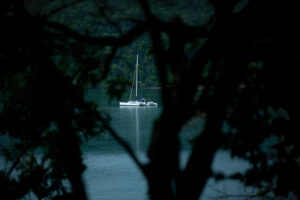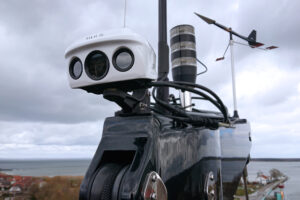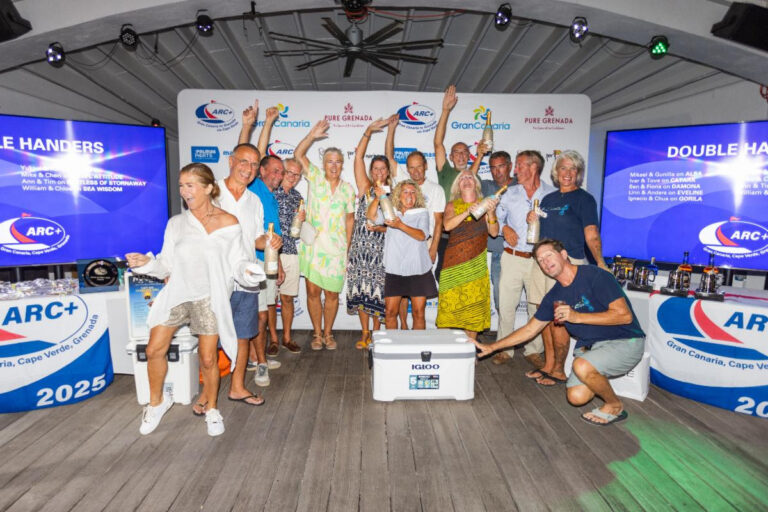
The Lipari 41 from Fountaine Pajot could be characterized as a typical cruising cat for its size. It has spacious accommodations, relatively high freeboard, a raised saloon with excellent visibility, and comes with a choice of layouts. And like similar cruising cats, it may not sail to weather like a narrow monohull, but off the wind, it’ll leave all but full-bore racing monohulls in the dust.
The Lipari also follows some of the newest design trends in cruising cats. It has significant headroom below and essential bridgedeck clearance that comes at the cost of increased windage. It’s also available in a three- or four-cabin configuration, with the three-cabin layout dedicating the entire starboard hull to the owner’s digs. Also, instead of the canvas bimini raised above the saloon’s coach roof that you’ll find on older cats, the Lipari follows the trend of simply extending the saloon coach roof over what could be called the cockpit but might more accurately be termed the “exterior lounge area.” You lose the “pillbox slit” between coach roof and bimini that’s found on older cats and retain visibility forward through the saloon windows and through the hatch in the roof for the raised helm station. The large cockpit roof also provides a solid and unbroken platform on which the crew can handle the mainsail and mount solar panels. The helm station centralizes the running rigging and provides seamless access to the deck as well as sightlines to the boat’s perimeter, or at least most of it.
The significant differences between the Lipari and other cats rest in devilish details and chosen compromises. Fountaine Pajot’s decks and hulls are PVC cored and vacuum bagged. The decks are among the biggest resin-infused parts in the world, and all tabbing and other construction details I looked at appeared clean and well executed. The Lipari is generally lighter and a bit more performance oriented than some of the other cats in its size range. Its sail area-to-displacement ratio also is a little higher than the other cats, providing a bit more power per pound. And by keeping freeboard just a touch lower and utilizing the increasingly popular and highly efficient full-battened square-headed mainsail, the mast height can be lower than similarly sized cats. This lowers the center of effort and reduces pitching. When it’s all added up, the Lipari 41 is spacious and comfortable both inside and out, and it’s no slouch under sail.
The 41’s performance orientation results in appointments that are slightly more minimal than those aboard the competition. The light and airy interior has a contemporary flair that one of Cruising World’s Boat of the Year judges described as IKEA-like. An example? The shower in the owner’s hull takes up a portion of the hull but is only partially partitioned; to take a shower, you must first snake a removable sink faucet through a hole in the partition to serve as the showerhead. Elsewhere, some lockers lack doors or covers. The interior is lightweight, and functional, but those wedded to traditional looks and fancy cabinetry may miss them on this boat. Also, if you’re heading offshore, where the world sometimes turns into a carnival ride, you may want more robust gear retainers and a few more handholds.
That said, the layout is spacious and workable. The berths are all large, and the cabins are well ventilated. Thanks to a flared chine inboard and above the waterline, the forward berths are even a little wider than you’ll find on many similarly sized cats. Some folks may bemoan crawling over the berth ends, but once you’re in, you’ll enjoy greater berth width and security. The galley features a stainless-steel double sink, a three-burner stove and separate oven, and good stowage space. The settee is simple and provides comfortable seating for four to six people. It also doubles as a good sea berth that’s handy to the cockpit. The nav station is adequate to modern needs.
The deck layout works pretty well, although taller BOTY judges knocked noggins on the cockpit roof, particularly when en route to the port side deck. On the positive side, the large sliding glass companionway door can be locked open to create a seamless transition between inside and outside. Lifelines and stanchions are sized properly, and the stanchions are securely bolted through a molded toerail. The engine hatches are well above water, and they open athwartships so the crew can work on the engines in any weather.
The anchoring system deploys the hook from its rollers that exit the fairing just forward of the main beam. Halyard tails are designed to fall into these large lockers, too, but owners will likely want to install halyard bags or bins to keep loose tails from becoming entangled with ground tackle, and the large locker top might better be divided to reduce windage when open.
It was pretty boisterous off Annapolis, Maryland, when we finally got out for our test sail of the Lipari 41 after the U.S. Sailboat Show. But once we got a reef tucked into the main, the Lipari stood up to the bashing briny, blasting along at 9 to 10 knots in 22 knots of wind with higher gusts. It also maneuvered easily and tacked from reach to reach without any hint of stalling. The seas were quite choppy, but we experienced no bridgedeck pounding.
Since the engines are placed well aft, the stern sections are full enough to keep the transoms from dragging. The placement of the engines also helps minimize the maintenance mess and engine noise in the aft cabins. Thanks to the boat’s twin 20-horsepower Volvo diesels (30-horsepower engines are optional), we wheeled about under power like a dancer and steamed at an easy 7 to 8 knots at 2,200 to 3,200 rpm. The boat’s significant tankage and battery capacity makes long-range cruising possible whether the wind blows or not. With less than 4 feet of draft, the Lipari can also sneak into shallow gunkholes as well.
If the latest tendency in cruising-cat design is to combine good sailing performance with minimal yet ultracomfortable interior accommodations, then the Lipari 41 is heading in the right direction.
Steve Callahan is a veteran CW BOTY judge.
Specs
LOA 39′ 2″ (11.89 m.)
LWL 38′ 8″ (11.79 m.)
Beam 22′ 1″ (6.73 m.)
Draft 3′ 8″ (1.12 m.)
Sail Area (100%) 726 sq. ft. (71.1 sq. m.)
Displacement 21,605 lb. (9,800 kg.)
D/L 164
SA/D 15.8
Water 140 gal. (530 l.)
Fuel 80 gal. (303 l.)
Holding 30 gal. (114 l.)
Mast Height 58′ 7″ (12.05 m.)
Engines Two 20-hp. Volvos
(30-hp. optional)
Designer Joubert-Nivelt Architects
Sailaway Price $358,495
Fountaine Pajot
+33-0-546-35-7040
www.fountaine-pajot.com








